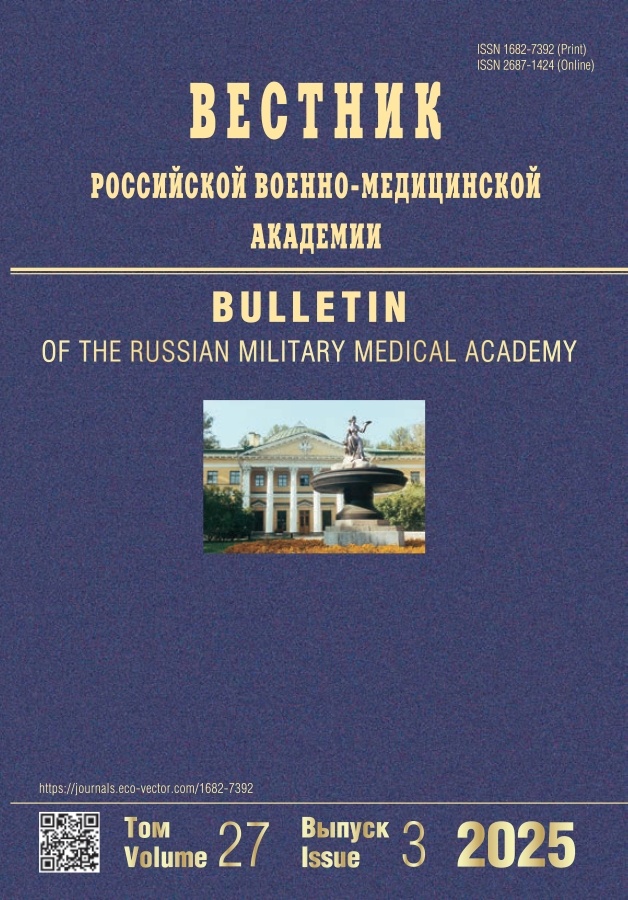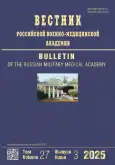Vacuum-assisted laparotomy in patients with penetrating gunshot wounds to the abdomen
- 作者: Pichugin A.A.1, Isaev T.A.2, Markevich V.Y.1, Suvorov V.V.1, Badalov V.I.1, Goncharov A.V.1,3, Samokhvalov I.M.1,4
-
隶属关系:
- Kirov Military Medical Academy
- 321 Military Clinical Hospital
- Russian University of Biotechnology
- Saint - Petersburg institute of emergency care n.a. I.I. Dzhanelidze
- 期: 卷 27, 编号 3 (2025)
- 页面: 341-352
- 栏目: Original Study Article
- URL: https://bakhtiniada.ru/1682-7392/article/view/319565
- DOI: https://doi.org/10.17816/brmma677826
- EDN: https://elibrary.ru/KACVZF
- ID: 319565
如何引用文章
详细
BACKGROUND: In modern armed conflicts, peritonitis incidence in penetrating abdominal injuries involving hollow organ damage reaches 31%.
AIM: This study aimed to evaluate the effectiveness of vacuum-assisted laparotomy as a temporary abdominal closure technique in the open abdomen approach for patients with penetrating abdominal gunshot wounds complicated by peritonitis.
METHODS: The outcomes of vacuum-assisted laparostomy were analyzed in 100 patients with penetrating abdominal gunshot wounds complicated by peritonitis between March 1, 2022, and March 1, 2024. The patients were divided into three groups based on hospital department and clinical outcome: group 1, 9 patients from the surgical department; group 2, 59 wounded patients from the anesthesiology and intensive care unit who underwent definitive abdominal closure; and group 3, 32 patients with documented in-hospital mortality. The patients in groups 1 and 2 were further subdivided according to definitive abdominal closure technique: layered closure of the abdominal wall (primary fascial closure) or skin-only closure of the laparotomy wound (planned ventral hernia) performed during the final relaparotomy. Each relaparotomy was performed with vacuum-assisted laparotomy according to a standardized protocol. Predictive models to achieve primary fascial closure and for in-hospital mortality were developed.
RESULTS: Primary fascial closure was achieved in 78% of group 1 cases and in 29% of group 2 cases (p < 0.007). In group 2, the planned ventral hernia subgroup had significantly more relaparotomies (p < 0.001), longer open abdomen duration (p < 0.001), and longer intensive care unit stays (p = 0.008) than the primary fascial closure subgroup. An increase in the duration of open abdomen management (group 2) by 1 day decreased the possibility of primary fascial closure by 18% (odds ratio [OR] = 0.817; 95% confidence interval [CI]: 0.706–0.945; p = 0.007). In group 2, a decrease in the interval between surgical interventions was a predictor of in-hospital mortality (OR = 0.934; 95% CI: 0.876–0.997; p = 0.040). An increase in patient age by 1 year increased the possibility of death by 15% (OR = 1.153; 95% CI: 1.035–1.284; p = 0.010), whereas a 1 point increase in organ failure severity score at the initiation of open abdomen approach increased it by 82% (OR = 1.817; 95% CI: 1.255–2.632; p = 0.002).
CONCLUSION: Achieving primary fascial closure is associated with a smaller number of preceding surgical interventions and duration of intensive care unit treatment. The shorter the open abdomen duration, the higher the possibility of primary fascial closure. Patient age and the initial organ failure severity score are potential predictors of in-hospital mortality in patients with penetrating abdominal gunshot wounds complicated by peritonitis.
作者简介
Artem Pichugin
Kirov Military Medical Academy
Email: vmeda-nio@mil.ru
ORCID iD: 0000-0002-2007-9161
SPIN 代码: 9813-9694
MD, Cand. Sci. (Med.)
俄罗斯联邦, Saint PetersburgTilek Isaev
321 Military Clinical Hospital
Email: vmeda-nio@mil.ru
ORCID iD: 0009-0009-4496-8914
SPIN 代码: 8629-5217
resident of the surgical department
俄罗斯联邦, 36 Gorkogo St., Chita, 672027Vitaliy Markevich
Kirov Military Medical Academy
Email: vmeda-nio@mil.ru
ORCID iD: 0000-0002-3792-1466
SPIN 代码: 5652-4935
MD, Dr. Sci. (Medicine), Associate Professor
俄罗斯联邦, Saint PetersburgVasiliy Suvorov
Kirov Military Medical Academy
编辑信件的主要联系方式.
Email: vmeda-nio@mil.ru
ORCID iD: 0000-0003-3381-5233
SPIN 代码: 7445-0491
MD, Cand. Sci. (Medicine), Associate Professor
俄罗斯联邦, Saint PetersburgVadim Badalov
Kirov Military Medical Academy
Email: vmeda-nio@mil.ru
ORCID iD: 0000-0002-8461-2252
SPIN 代码: 9314-5608
MD, Dr. Sci. (Med.), Professor
俄罗斯联邦, Saint PetersburgAlexey Goncharov
Kirov Military Medical Academy; Russian University of Biotechnology
Email: vmeda-nio@mil.ru
ORCID iD: 0000-0001-9807-1496
SPIN 代码: 1270-7269
MD, Dr. Sci. (Medicine), Associate Professor
俄罗斯联邦, Saint Petersburg; MoscowIgor Samokhvalov
Kirov Military Medical Academy; Saint - Petersburg institute of emergency care n.a. I.I. Dzhanelidze
Email: vmeda-nio@mil.ru
ORCID iD: 0000-0003-1398-3467
SPIN 代码: 4590-8088
MD, Dr. Sci. (Medicine), Professor
俄罗斯联邦, Saint Petersburg; Saint Petersburg参考
- Samohvalov IM, ed. Military Field Surgery: A National Guide. Moscow: GEOTAR-Media; 2024. 1057 p. (In Russ.)
- Coccolini F, Roberts D, Ansaloni L, et al. The open abdomen in trauma and non-trauma patients: WSES guidelines. World J Emerg Surg. 2018;13:7. doi: 10.1186/s13017-018-0167-4 EDN: XXFHRB
- Roberts DJ, Leppäniemi A, Tolonen M, et al. The open abdomen in trauma, acute care, and vascular and endovascular surgery: comprehensive, expert, narrative review. BJS Open. 2023;7(5):zrad084. doi: 10.1093/bjsopen/zrad084 EDN: GBKGGV
- Brown LR, Rentea RM. Temporary abdominal closure techniques. In: StatPearls. Treasure Island (FL): StatPearls Publishing; 2024. P. 2–12.
- Miller PR, Meredith JW, Johnson JC, Chang MC. Prospective evaluation of vacuum-assisted fascial closure after open abdomen: planned ventral hernia rate is substantially reduced. Ann Surg. 2004;239(5):608–616. doi: 10.1097/01.sla.0000124291.09032.bf
- Coccolini F, Biffl W, Catena F, et al. The open abdomen, indications, management and definitive closure. World J Emerg Surg. 2015;10:32. doi: 10.1186/s13017-015-0026-5 EDN: PONNPC
- Roberts DJ, Ball CG, Feliciano DV, et al. History of the innovation of damage control for management of trauma patients: 1902-2016. Ann Surg. 2017;265(5):1034–1044. doi: 10.1097/SLA.0000000000001803
- Demetriades D. Total management of the open abdomen. Int Wound J. 2012;9(Suppl 1):17–24. doi: 10.1111/j.1742-481X.2012.01018.x
- Zosa BM, Como JJ, Kelly KB, et al. Planned ventral hernia following damage control laparotomy in trauma: an added year of recovery but equal long-term outcome. Hernia. 2016;20(2):231–238. doi: 10.1007/s10029-015-1377-2 EDN: KMYNCP
- Björck M, D'Amours SK, Hamilton AE. Closure of the open abdomen. Am Surg. 2011;77(Suppl 1):S58-S61.
- Carlson GL, Patrick H, Amin AI, et al. Management of the open abdomen: a national study of clinical outcome and safety of negative pressure wound therapy. Ann Surg. 2013;257(6):1154–1159. doi: 10.1097/SLA.0b013e31828b8bc8
- Heo Y, Kim DH. The temporary abdominal closure techniques used for trauma patients: a systematic review and meta-analysis. Ann Surg Treat Res. 2023;104(4):237–247. doi: 10.4174/astr.2023.104.4.237 EDN: IFHRYT
- Cristaudo AT, Jennings SB, Hitos K, et al. Treatments and other prognostic factors in the management of the open abdomen: a systematic review. J Trauma Acute Care Surg. 2017;82(2):407–418. doi: 10.1097/TA.0000000000001314
- De Waele JJ, Kaplan M, Sugrue M, et al. How to deal with an open abdomen? Anaesthesiol Intensive Ther. 2015;47(4):372–378. doi: 10.5603/AIT.a2015.0023
- Granger S, Fallon J, Hopkins J, Pullyblank A. An open and closed case: timing of closure following laparostomy. Ann R Coll Surg Engl. 2020;102(7):519–524. doi: 10.1308/rcsann.2020.0105 EDN: WNGDCO
- Pommerening MJ, DuBose JJ, Zielinski MD, et al. Time to first take-back operation predicts successful primary fascial closure in patients undergoing damage control laparotomy. Surgery. 2014;156(2):431–438. doi: 10.1016/j.surg.2014.04.019
- Miller RS, Morris JA Jr, Diaz JJ Jr, et al. Complications after 344 damage-control open celiotomies. J Trauma. 2005;59(6):1365–1374. doi: 10.1097/01.ta.0000196004.49422.af
- Einav S, Zimmerman FS, Tankel J, Leone M. Management of the patient with the open abdomen. Curr Opin Crit Care. 2021;27(6):726–732. doi: 10.1097/MCC.0000000000000879 EDN: URLJRJ
- Burlew CC, Moore EE, Cuschieri J, et al. Sew it up! A Western Trauma Association multi-institutional study of enteric injury management in the postinjury open abdomen. J Trauma. 2011;70(2):273–277. doi: 10.1097/TA.0b013e3182050eb7
- Fernández LG. Management of the open abdomen: clinical recommendations for the trauma/acute care surgeon and general surgeon. Int Wound J. 2016;13(Suppl 3):25–34. doi: 10.1111/iwj.12655
补充文件











